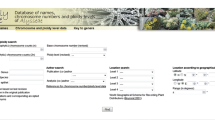Abstract
A study of approximately 300 plants in the taxonomic species B. lineariloba is reported. Five biological species differing in chromosome number exist in this species complex. The species with the lowest number (species A, n = 2) often carries B chromosomes, which may be large, or minute. It also exists in three racial forms which differ in karyotype. Observations on naturally occurring hybrids in zones of overlap show that two of the races differ by an unequal interchange. — The species with n = 8 (species C) is probably of amphidiploid origin from the cross A X B. Species B, E and D, with n = 6, 5 and 4 respectively, may represent a series of reductions in chromosome number. They show close karyotypic relationships. The relationship of species A with D, E and B is obscure.
Similar content being viewed by others
References
Davis, G. L.: A revision of the genus Brachycome. Proc. Linn. Soc., N. S. Wales 73, 142–241 (1948).
Essad, S., Arnaux, J., Maia, N.: Contrôle de validité des caryogrammes. Chromosoma (Berl.) 20, 202–220 (1966).
Jackson, R. C.: A study of meiosis in Haplopappus gracilis (Compositae). Amer. J. Bot. 46, 550–554 (1959).
— Supernumerary chromosomes in Haplopappus gracilis. Evolution (Lancaster, Pa.) 14, 135 (1960).
Jackson, R. C.: Interspecific hybridisation in Haplopappus and its bearing on chromosome evolution in the Blepharodon section. Amer. J. Bot. 49, 119–132 (1962).
A cytogenetic study of a three-paired race of Haplopappus gracilis. Amer. J. Bot. 52, 946–953 (1965).
Lewis, F. H.: Catastrophic selection as a factor in speciation. Evolution (Lawrence, Kans.) 16, 257–271 (1962).
Newcomer, E. H.: A new cytological and histological fixing fluid. Science 118, 161 (1953).
Patau, K. A.: The identification of individual chromosomes, especially in man. Amer. J. hum. Genet. 12, 250–276 (1960).
Smith-White, S.: Brachycome lineariloba. A species for experimental cytogenetics. Chromosoma (Berl.) 23, 359–364 (1968).
-Carter, C. R., Stace, H. M.: The cytology of Brachycome. Austr. J. Bot. (in press, 1970).
Stebbins, G. L.: Longevity, habitat and release of genetic variability in higher plants. Cold Spr. Harb. Symp. quant. Biol. 23, 365–378 (1958).
Author information
Authors and Affiliations
Rights and permissions
About this article
Cite this article
Smith-White, S., Carter, C.R. The cytology of Brachycome lineariloba . Chromosoma 30, 129–153 (1970). https://doi.org/10.1007/BF00281996
Received:
Accepted:
Issue Date:
DOI: https://doi.org/10.1007/BF00281996




